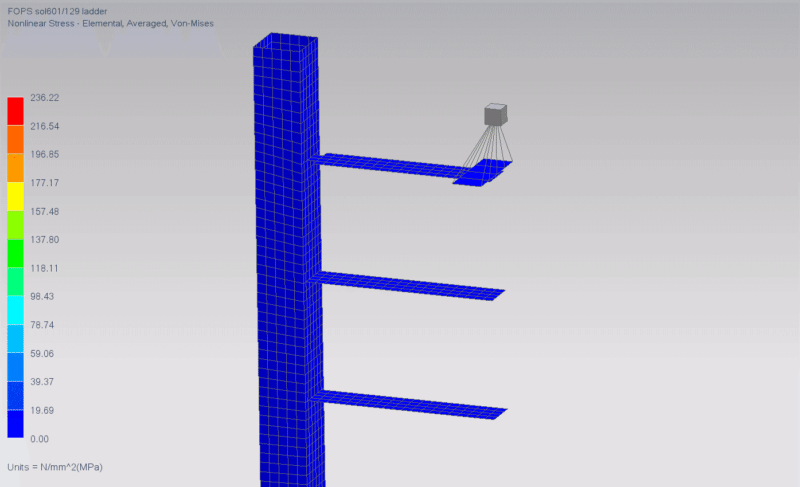glulambeam
Mechanical
thread825-204956
I have a cover that I need to analyze for an impact load (in this case, a 1 lb object that is dropped from a height of 20 in). I have an analysis document, but the person who wrote it skipped a bunch of steps and also might be too busy to answer any questions/get involved.
Using equations for energy, it's computed that the velocity of the 1 lbs object is 125 in/s when it hits. this velocity is converted into a set of enforced displacements to apply directly to a FEA model of the cover (which is basically a cylinder; there's a cap on the top surface of the cylinder, and a rectangular plate on the bottom surface of the cylinder, and the rectangular piece bolts down at the four corners):
(a) when the impact occurs on the top of the cover (flat), the enforced displacement is 0.0134"
(b) when the impact occurs on the side of the cover (cylindrical), the enforced displacement is 0.0193"
At least these are the numbers shown on the screenshots.
So the questions are:
(1) How do I do the velocity to enforced displacement conversion? I thought this was some sort of response simulation within NX10 for transient load, but that's just a wild guess. I've seen this analysis in a document floating around on the internet from ATA engineering, but they used I-DEAS and some of the steps were unintelligible.
(2) I'm hoping/assuming that I don't need to bust out abaqus to do any of this? I do not know how to use that software and this thing's due in about two weeks (that sounds like alot of time but I have other tasks I have to do as well).
Please advise. Thanks in advance.
I have a cover that I need to analyze for an impact load (in this case, a 1 lb object that is dropped from a height of 20 in). I have an analysis document, but the person who wrote it skipped a bunch of steps and also might be too busy to answer any questions/get involved.
Using equations for energy, it's computed that the velocity of the 1 lbs object is 125 in/s when it hits. this velocity is converted into a set of enforced displacements to apply directly to a FEA model of the cover (which is basically a cylinder; there's a cap on the top surface of the cylinder, and a rectangular plate on the bottom surface of the cylinder, and the rectangular piece bolts down at the four corners):
(a) when the impact occurs on the top of the cover (flat), the enforced displacement is 0.0134"
(b) when the impact occurs on the side of the cover (cylindrical), the enforced displacement is 0.0193"
At least these are the numbers shown on the screenshots.
So the questions are:
(1) How do I do the velocity to enforced displacement conversion? I thought this was some sort of response simulation within NX10 for transient load, but that's just a wild guess. I've seen this analysis in a document floating around on the internet from ATA engineering, but they used I-DEAS and some of the steps were unintelligible.
(2) I'm hoping/assuming that I don't need to bust out abaqus to do any of this? I do not know how to use that software and this thing's due in about two weeks (that sounds like alot of time but I have other tasks I have to do as well).
Please advise. Thanks in advance.

